I cannot do justice to the concept of leadership in one article, but let us hit the highlights.
Leadership is what most market commentators want when they complain about "politicians." They want leaders of democracies to ignore the demands of constituents and do what is right. Unfortunately, the punditry has widely varying views on the best course of action!
The search for leadership is hitting center stage.
Leadership requires more than accepting and following opinion polls. It includes finding solutions and convincing people that this is the right path. Bringing contending parties together. Finding compromises. Personal charisma. A persuasive presence. Confidence in the face of crisis.
The need for strong leadership is readily apparent, but why the focus right now? I see three factors:
- The upcoming Greek election, which may well determine whether Greece leaves the Eurozone and on what terms;
- Increased urgency among European leaders, as austerity programs fail both with voters and in economic results;
- Intensifying US politics, with a new focus on the personal skills of the candidates.
This last point, highlighted by Obama's press conference comments, will be the big topic for the weekend talk shows and featured in financial news this week. It is difficult to find a really neutral link for this subject, and you can easily find many on your own, but this coverage from Business Insider provides both facts and context. It shows the actual statement and plenty of quotations from Republicans, but also some data.
I'll offer some thoughts on this in the conclusion, but first let's do our regular review of the events and data from last week.
Background on "Weighing the Week Ahead"
There are many good sources for a list of upcoming events. With foreign markets setting the tone for US trading on many days, I especially like the comprehensive calendar from Investing.com. There is also helpful descriptive and historical information on each item.
In contrast, I highlight a smaller group of events. My theme is an expert guess about what we will be watching on TV and reading in the mainstream media. It is a focus on what I think is important for my trading and client portfolios.
This is unlike my other articles where I develop a focused, logical argument with supporting data on a single theme. Here I am simply sharing my conclusions. Sometimes these are topics that I have already written about, and others are on my agenda. I am putting the news in context.
Readers often disagree with my conclusions. Do not be bashful. Join in and comment about what we should expect in the days ahead. This weekly piece emphasizes my opinions about what is really important and how to put the news in context. I have had great success with my approach, but feel free to disagree. That is what makes a market!
Last Week's Data
Each week I break down events into good and bad. Often there is "ugly" and on rare occasion something really good. My working definition of "good" has two components:
- The news is market-friendly. Our personal policy preferences are not relevant for this test. And especially -- no politics.
- It is better than expectations.
The US economic data last week was more positive than in recent weeks.
- Technical selling was averted. This was a big fear last week. Josh Brown did a great job of explaining why this might not happen. I hope readers followed our link to his analysis.
- ISM Services index showed continued expansion. Steven Hansen does a good job of analyzing the internal elements and also provides a helpful chart.
- Spain has agreed to accept outside aid for its banking system. The $125 billion is three times the amount cited by the IMF as needed. (New York Times). The terms were structured with an emphasis on bank reforms rather than new austerity measures. German officials praised Spain. This is the sort of face-saving compromise action that investors should be watching as a sign of progress, as I suggested in my Europe surprise ending article.
- Sentiment continues to be very negative, which is positive for markets. Steven Hansen highlights the increased bearishness in the Ticker Sense survey of bloggers (including here). The Bespoke Investment Group shows the same picture for individual investors.
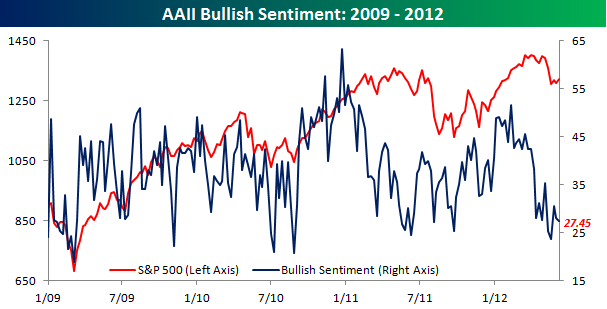
- US household balance sheets are $1 trillion better than in 2007. Scott Grannis notes that this has not led to the widely-predicted economic implosion.
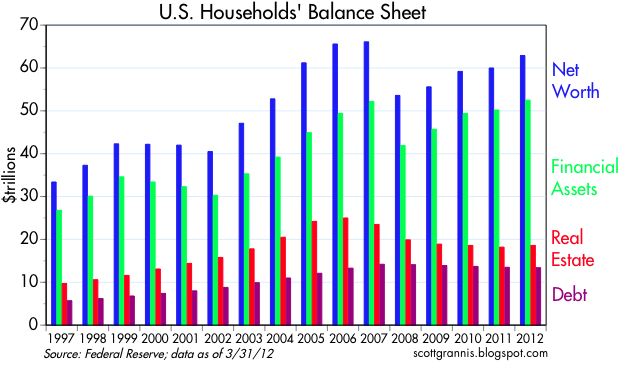
The Bad
There was also some bad news on the economic data front.
- France lowers the retirement age by two years, to age 60 for some workers.
- The European bank"job" continues -- good story from Floyd Norris at the NYT.
- US debt will reach 200% of GDP by 2037, according to the CBO, if Congress extends current tax policy without cutting entitlements.
- Initial jobless claims remain at unacceptably elevated levels. I see this as the most important of the weekly data series. The chart from Doug Short shows why:
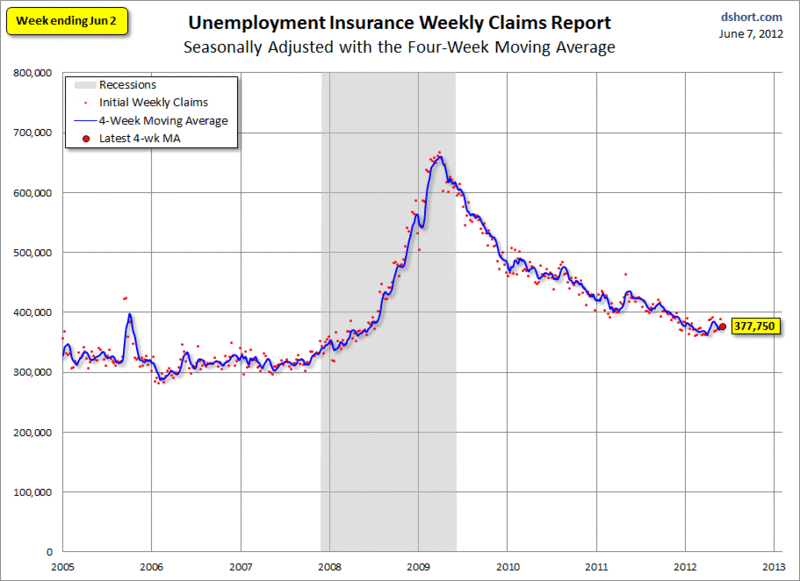
- Big US banks face downgrades according to the WSJ.
- PMI reports from around the world have been weaker. Dr. Ed Yardeni has a good discussion about the differences between the US, China, and Europe. The US is holding up best, but there is a general weakening pattern as you can see from this chart:
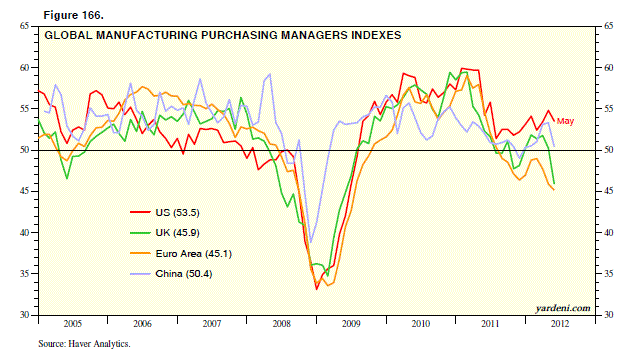
The Ugly
The Greek television talk show wins this week's "ugly" award. The neo-Nazi politican is now on the lam after slapping and slugging a woman from the Communist party. The New Athenian is one of our featured sources, so we recommend this video of the incident, where John Psaropoulos does the reporting.
Speculation ranges widely on what effect this might have on the upcoming election. No guesses here!
The Indicator Snapshot
It is important to keep the current news in perspective. My weekly snapshot includes the most important summary indicators:
- The St. Louis Financial Stress Index.
- The key measures from our "Felix" ETF model.
- An updated analysis of recession probability.
The SLFSI reports with a one-week lag. This means that the reported values do not include last week's market action. The SLFSI has moved a lot lower, and is now out of the trigger range of my pre-determined risk alarm. This is an excellent tool for managing risk objectively, and it has suggested the need for more caution. Before implementing this indicator our team did extensive research, discovering a "warning range" that deserves respect. We identified a reading of 1.1 or higher as a place to consider reducing positions.
The SLFSI is not a market-timing tool, since it does not attempt to predict how people will interpret events. It uses data, mostly from credit markets, to reach an objective risk assessment. The biggest profits come from going all-in when risk is high on this indicator, but so do the biggest losses.
The C-Score is a weekly interpretation of the best recession indicator I found, Bob Dieli's "aggregate spread." I'll explain more about the C-Score soon. We are working on a modification that will make this method even more sensitive. None of the recession methods are worrisome. Bob also has a group of coincident indicators. Like most of the top recession forecasters, he uses these to confirm the long-term prediction. These indicators are also not close to a recession signal.
For comprehensive recession forecasting we recommend the RecessionAlert team. They have reverse-engineered the ECRI approach and improved on the recession forecasting power. Since they have not gotten the mainstream recognition they deserve, you can still enjoy the advantage from their methods. You should consider subscribing for more detailed reports covering various time frames and GDP forecasting. 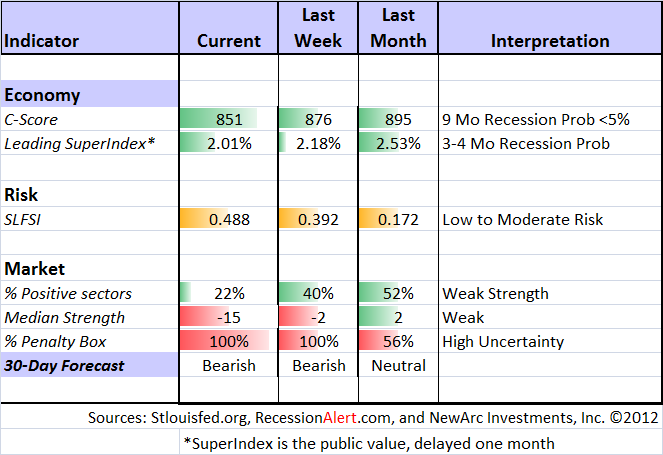
Our "Felix" model is the basis for our "official" vote in the weekly Ticker Sense Blogger Sentiment Poll. We have a long public record for these positions. This week we continued as "bearish" and were 1/3 short via DOG in trading accounts during the week. The ratings are close to neutral. There are sectors in the buy range which might emerge from the penalty box, so this is a very fluid situation. It is bearish, but marginally so.
[For more on the penalty box see this article. For more on the system ratings, you can write to etf at newarc dot com for our free report package or to be added to the (free) weekly ETF email list. You can also write personally to me with questions or comments, and I'll do my best to answer.]
The Week Ahead
I was correct last week in my prediction that the financial news would have a Fed fixation. All of the Fed speeches, including Bernanke's testimony, passed uneventfully. The Beige Book showed a the economic strength that the Fed sees but traders do not. Yellen offered some QE hope, but Bernanke did not. We are now waiting until next week's FOMC report without any further direction.
There is plenty of data this week, but little that I see as important. I don't expect much on the inflation front and I do not care about regional surveys like the Empire State Index.
On Thursday we will see initial jobless claims, still in the survey period for the next employment report. On Friday we get industrial production, capacity utilization, and Michigan sentiment. Then we get pre-weekend speculation about Greece and options expiration.
I expect the first part of the week to focus on the leadership questions, with attacks on Obama as "out of touch."
Trading Time Frame
We have been partially invested in trading accounts, in a bearish position with 1/3 of our position profitably in bond ETFs and another 1/3 in an inverse (short) ETF, as I predicted last week. Felix has now sent the bond position to the penalty box, so we have a cautious short position.
Investor Time Frame
For investment accounts I have been buying on dips in stocks that we like. I tried to explain the most important concept for individual investors in this article about the Wall of Worry. I have had many emails from people who had a personal breakthrough in their investing when they understood this concept. If you missed it, I urge you to take a look. You can contrast this with the many pundits who claim miracles of market timing.
The single most difficult thing for me to explain is that investors should often embrace opportunity just as traders are trying to do some fancy footwork. Investors should not be trying to guess the next market move. Instead, take what the market is giving you. You should not be a "buy and hold" investor, but instead engage in active management. Think about risk control rather than market timing.
To highlight the continuing discrepancy between headlines and the economic fundamentals, let us look to Dr. Ed. He compares various alternative investments to stocks, using the trailing earnings. This chart summarized a point that was widely observed in the past week. 
The earnings yield from stocks, when compared to corporate bond yields, is at a 50-year spread. This suggests extreme skepticism about corporate earnings. Another way to view this is that it is the greatest fear since the mid-70's. If the two lines simply met, the S&P 500 would have to rally by 27%. This is conservative, since you can see that the bonds usually trade at a higher yield. If you used forward earnings or Treauries, the so-called Fed model, you would get an even larger discrepancy.
The biggest mistake that individual investors make is bad timing by following headlines. Using data is a way to avoid that.
Long-term investors who ignore this warning can follow "Plan B." You can imitate our enhanced yield program. Buy good dividend stocks and sell short-term calls. I am targeting 8-9% returns on this approach, and achieving it over the course of a market cycle. You can, too. With the increase in volatility, there are many good opportunities.
Final Thoughts on Leadership
I have a very good record of predicting what will happen, especially on political events. Eventually this pays off, since earnings follow and stock prices eventually track earnings.
My concern is that sometimes perceptions create their own reality.
Suppose you are considering a major business expansion -- a new product, new plant, or new employees. Economic uncertainty is the enemy of such plans, since you have less confidence in your forecasts.
Suppose your family is considering a new job, a new home, or a new car. Uncertainty can create a delay.
This is why the effect of leadership is important. Even if all will eventually end well, people need to have some confidence. Otherwise, why not wait until after the Greek elections, after the Europeans solve the problems, after the fiscal cliff is addressed, after the US elections......
This is why the extended US political process is so destructive, particularly when it incorrectly focuses on the personal competence of the candidates.
Here is a secret: The things most important to investors will be fine no matter who is elected. Both candidates are competent and will have great supporting teams.
The perceptions create an economic drag, but investors who wait for everything to be fixed will be buying at Dow 20K.
This is a challenging subject and I need more articles to explain. Meanwhile, I try each week to highlight the most important things I am following.
